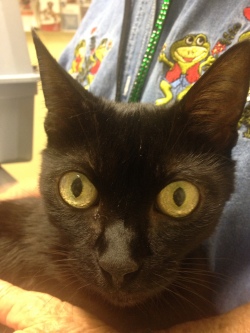Cat Bite Abscess Healing Process

This slideshow requires JavaScript.
How Does a Bite Wound Heal?
Remember Minnie from VirtuaVet’s last story about cat bite wounds?
Drains Prevent Sepsis
First, Minnie was supposed to come visit Doc Truli three to five days after her original surgery in order to have her Penrose latex drains removed from underneath her skin on her right hind leg.
“I had to take care of an emergency with my family, and then I was in the hospital, and it just didn’t happen,” said Minnie’s human. “I kept it clean and dry.”
Doc Truli evaluated the drains and the wound healing. “Minnie’s lucky. She’s healing really well. We have to remove these drains and make sure there are no pieces of latex stuck under her skin. They would act like a foreign body and cause a severe reaction,” said Doc Truli.
Here you can review the before and after pictures of the drains. The drains were left in too long, which risked bacteria travelling back up the drains and into the body.
“If your cat has a drain in place to keep a wound from harboring injection, you need proper drain care, including having your veterinarian remove the drain in 3-5 days to ensure the best results,” says Doc Truli.”
After 2 weeks, these drains look discolored. The normal light creamy yellow-white has turned a burnt yellow-orange nasty color. The drains tore at the suture puncture sites close to the skin and the one drain ripped from it’s placement sutures and partly pulled through the skin. It did not effectively drain the whole pocket along the cat’s upper thigh. Doc Truli noted the bite hole on the top of the caudal (pronounced caw-dull), or back of the thigh was still oozing some yellow pus-like liquid.
Sequestered Infection Can Complicate Healing
“Minnie’s healing is going well, but she is at risk for sequestering an infection and it may erupt later in the upcoming days, weeks, or months,” said Doc Truli. “I’ve even seen a hidden, sequestered foreign body come out of a draining fistula or tract eleven years after the original injury.” (That’s a story for another day!)
How Does the Body Heal a Hole in the Skin?
The original bite holes looked like precise little vicious lacerations or cuts. After 2 weeks, you can appreciate the rounded edges of the holes as the microscopic fibroblast elastic fibers pull the wound edges together to cover the pink healthy underlying granulation tissue. Once the skin has pulled into the wound area as much as it can – about two centimeters – then it will start to epithelialize (pronounced eh-pi-theel-lee-all-lies) and march a thin layer of skin cells out across any remaining desert of granulation tissue than has not yet been covered with full thickness skin. The thin layer of cells will be more fragile than regular skin for the rest of the patient’s lifetime and will not have structures like hair follicles or fur.
Tru Geek Bit
Fibroblasts are specialized connective tissue cells arising from the embryonic mesoderm. Say what?
Okay, in a mammal embryo in the beginning stages when the egg cell is fertilized and starts to divide and divide and doubles every few minutes and then hours, the cells quickly identify as three layers. Scientists call then ectoderm (ecto meaning outer), mesoderm (meso meaning middle), and endoderm (endo meaning inside).
- Ectoderm
- Mesoderm
- Endoderm
If an embryo were a s’mores
So, if you imagine the embryo as forming an outside, inside and middle layer and then stretch them into sheets that fold and curve and twist on each other, you can imagine the original s’more of 2 layers with the marshmallow middle stretching and bending into shapes. The mesoderm is the marshmallow layer. Everything it ever becomes in the future of the life form after those initial few days will think it is mesoderm. The mesoderm always becomes the same stuff: bones, muscles, cartilage, connective tissue, kidneys, gonads (reproductive organs), dermis, heart, blood vessels, circulatory system. (The endoderm forms linings of things like the intestines, bronchial tubes, urinary bladder, lining of the auditory tube and tympanic membrane, lining cells of the liver, pancreas, thyroid and thymus. The ectoderm forms mostly spinal cord, nervous system and skin.)
How the marshmallow layer heals a bite hole
Back to fibroblasts. They form connective tissue and the structure of the extracellular matrix. When your matrix suffers toxicity, injury,even something huge like a cur, these fibroblasts start synthesizing new matrix within seconds. If relation to healing a hole in the skin, they have cellular elastic muscles that pull the skin toward the center of the defect to stretch full-thickness skin over the hole. This process can handle a defect up to about an inch or two centimeters.






